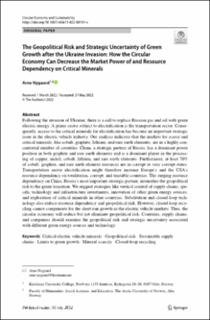| dc.description.abstract | Following the invasion of Ukraine, there is a call to replace Russian gas and oil with green electric energy. A prime sector subject to electrification is the transportation sector. Consequently, access to the critical minerals for electrification has become an important strategic issue in the electric vehicle industry. Our analysis indicates that the markets for scarce and critical minerals, like cobalt, graphite, lithium, and rare earth elements, are in a highly concentrated number of countries. China, a strategic partner of Russia, has a dominant power position in both graphite and rare earth elements and is a dominant player in the processing of copper, nickel, cobalt, lithium, and rare earth elements. Furthermore, at least 70% of cobalt, graphite, and rare earth element resources are in corrupt or very corrupt states. Transportation sector electrification might therefore increase Europe’s and the USA’s resource dependency on totalitarian, corrupt, and unstable countries. The surging resource dependency on China, Russia’s most important strategic partner, intensifies the geopolitical risk to the green transition. We suggest strategies like vertical control of supply chains, specific technology and infrastructure investments, innovation of other green energy sources, and exploration of critical minerals in other countries. Substitution and closed-loop technology also reduce resource dependency and geopolitical risk. However, closed-loop recycling cannot compensate for the short-run growth in the electric vehicle markets. Thus, the circular economy will reduce but not eliminate geopolitical risk. Countries, supply chains, and companies should examine the geopolitical risk and strategic uncertainty associated with different green energy sources and technology. | en_US |

